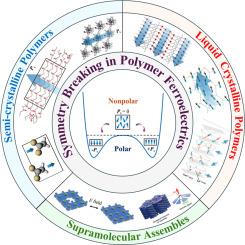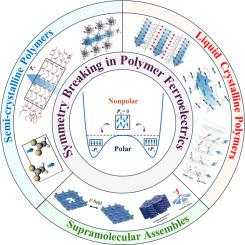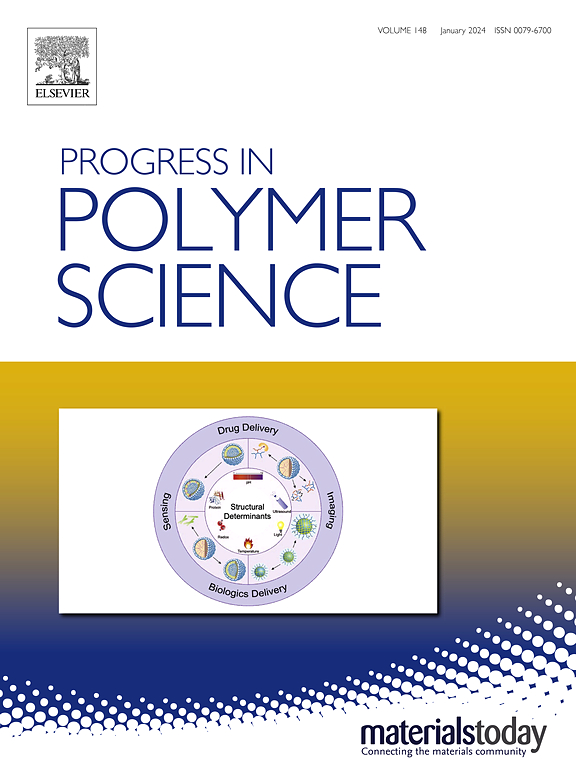Recent progress and trends in developing polymer ferroelectrics
IF 26.1
1区 化学
Q1 POLYMER SCIENCE
引用次数: 0
Abstract
In polymer ferroelectrics, spontaneous polarization is linked to the symmetry breaking of permanent dipolar elements, which usually arises from strong dipolar interactions or introduced chirality. Recently, there have been rapid and significant advances in understanding how molecular design and dipolar interactions dictate ferroelectric order in the soft matter field. These insights could greatly enhance our comprehension of polymer ferroelectrics and prompt a reevaluation of their design principles. In this review, we explore the origins of ferroelectricity in polymers, highlighting the critical role of dipolar interactions. We present a comprehensive collection and categorization of all polymer ferroelectrics, including both fluorinated and non-fluorinated systems. Additionally, we discuss domain size, domain wall, and topological engineering of polymer ferroelectrics, followed by an examination of representative and emerging applications. Finally, we offer perspectives on the future development of polymer ferroelectrics, focusing on novel non-fluorinated polymer systems, the flexible tuning of physical properties and performance, and the precise control of topology and polarization distribution.


聚合物铁电材料的研究进展及趋势
在聚合物铁电体中,自发极化与永久偶极元素的对称性破缺有关,这通常是由强偶极相互作用或引入手性引起的。最近,在理解分子设计和偶极相互作用如何决定软物质场中的铁电秩序方面取得了迅速而重大的进展。这些见解可以大大提高我们对聚合物铁电体的理解,并促使对其设计原则的重新评估。在这篇综述中,我们探讨了铁电在聚合物中的起源,强调了偶极相互作用的关键作用。我们提出了一个全面的收集和分类的所有聚合物铁电体,包括氟化和非氟化系统。此外,我们讨论了畴的尺寸,畴壁和聚合物铁电体的拓扑工程,随后检查了代表性和新兴的应用。最后,我们对聚合物铁电体的未来发展进行了展望,重点关注新型无氟聚合物体系,物理性质和性能的柔性调谐以及拓扑和极化分布的精确控制。
本文章由计算机程序翻译,如有差异,请以英文原文为准。
求助全文
约1分钟内获得全文
求助全文
来源期刊

Progress in Polymer Science
化学-高分子科学
CiteScore
48.70
自引率
1.10%
发文量
54
审稿时长
38 days
期刊介绍:
Progress in Polymer Science is a journal that publishes state-of-the-art overview articles in the field of polymer science and engineering. These articles are written by internationally recognized authorities in the discipline, making it a valuable resource for staying up-to-date with the latest developments in this rapidly growing field.
The journal serves as a link between original articles, innovations published in patents, and the most current knowledge of technology. It covers a wide range of topics within the traditional fields of polymer science, including chemistry, physics, and engineering involving polymers. Additionally, it explores interdisciplinary developing fields such as functional and specialty polymers, biomaterials, polymers in drug delivery, polymers in electronic applications, composites, conducting polymers, liquid crystalline materials, and the interphases between polymers and ceramics. The journal also highlights new fabrication techniques that are making significant contributions to the field.
The subject areas covered by Progress in Polymer Science include biomaterials, materials chemistry, organic chemistry, polymers and plastics, surfaces, coatings and films, and nanotechnology. The journal is indexed and abstracted in various databases, including Materials Science Citation Index, Chemical Abstracts, Engineering Index, Current Contents, FIZ Karlsruhe, Scopus, and INSPEC.
 求助内容:
求助内容: 应助结果提醒方式:
应助结果提醒方式:


